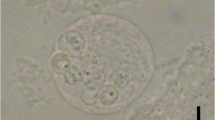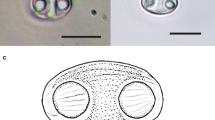Abstract
Two spore stages in the life cycle of Myxobilatus gasterostei, a ubiquitous myxosporean parasite of three-spined sticklebacks, were identified by matching small subunit ribosomal RNA gene sequences of actinospores from a worm with myxospores from fish. A Nais communis oligochaete collected in the Willamette River, Oregon, USA was found to produce a triactinomyxon-type actinospore which was distinguishable from previous records by its large size (∼500 μm across) and number of germ cells (∼500). Its small subunit ribosomal RNA gene sequence was >99% similar to M. gasterostei from Europe. Two of ten sticklebacks from the Willamette had renal infections with Myxobilatus myxospores which were smaller than the type description of M. gasterostei Parisi (1912) but were consistent with subsequent records. Primer Mg1097r was designed to selectively amplify M. gasterostei in the presence of another common kidney myxosporean, Sphaerospora elegans. DNA sequences of spores from the fish were identical to each other and were 99.8% similar over 2,112 nt to the spores from the oligochaete. The 0.2% sequence divergence comprised polymorphisms at five loci, which suggested that multiple alleles were present in the parasite population. This is the first Myxobilatus species shown to have two spore stages in its life cycle and to infect an invertebrate. The infected oligochaete underwent paratomic fission to produce two daughter worms with parasite stages in their intestinal epithelia, which suggested that M. gasterostei may be sustained and dispersed within the invertebrate host population.





Similar content being viewed by others
References
Arthur JR, Margolis L (1975) Two species of Myxobilatus (Myxosporida: Myxobilatidae) from freshwater fishes of western Canada, with description of M. yukonensis sp. nov. Can J Zool 53:1663–1668
Barta JR, Martin DS, Liberator PA, Dashkevicz M, Anderson JW, Feighner SD, Elbrecht A, Perkins-Barrow A, Jenkins MC, Danforth D, Ruff MD, Profous-Juchelka H (1997) Phylogenetic relationships among eight Eimeria species infecting domestic fowl inferred using complete small subunit ribosomal DNA sequences. J Parasitol 83:262–271
Bely AE, Wray GA (2004) Molecular phylogeny of naidid worms (Annelida: Clitellata) based on cytochrome oxidase I. Mol Phylogenet Evol 30:50–63
Diamant A, Whipps CM, Kent ML (2004) A new species of Sphaeromyxa (Myxosporea: Sphaeromyxina: Sphaeromyxidae) in devil firefish, Pterois miles (Scorpaenidae), from the northern Red Sea: morphology, ultrastructure, and phylogeny. J Parasitol 90:1434–1442
Fiala I (2006) The phylogeny of Myxosporea (Myxozoa) based on small subunit ribosomal RNA gene analysis. Int J Parasitol 36:1521–1534
Großheider G, Körting W (1992) First evidence that Hoferellus cyprini (Doflein, 1898) is transmitted by Nais sp. Bull Eur Assoc Fish Pathol 12:17–20
Hall TA (1999) BioEdit: a user-friendly biological sequence alignment editor and analysis program for Windows 95/98/NT. Nucleic Acids Symp Series 41:95–98
Hallett SL, Diamant A (2001) Ultrastructure and smallsubunit ribosomal DNA sequence of Henneguya lesteri n.sp. (Myxosporea), a parasite of sand whiting Sillago analis (Sillaginidae) from the coast of Queensland, Australia. Dis Aquat Org 46:197–212
Hallett SL, Erséus C, O’Donoghue PJ, Lester RJG (2001) Parasite fauna of Australian marine oligochaetes. Mem Queensl Mus 46:555–576
Hallett SL, Atkinson SD, El-Matbouli M (2002) Molecular characterisation of two aurantiactinomyxon (Myxozoa) phenotypes reveals one genotype. J Fish Dis 25:627–631
Holzer AS, Sommerville C, Wootten R (2004) Molecular relationships and phylogeny in a community of myxosporeans and actinosporeans based on their 18S rDNA sequences. Int J Para 34:1099–1111
Holzer AS, Sommerville C, Wootten R (2006) Molecular identity, phylogeny and life cycle of Chloromyxum schurovi Schul’man & Ieshko 2003. Parasitol Res 99:90–96
Holzer AS, Wootten R, Sommerville C (2007) The secondary structure of the unusually long 18S ribosomal RNA of the myxozoan Sphaerospora truttae and structural evolutionary trends in the Myxozoa. Int J Parasitol 37:1281–1295
Janiszewska J (1957) Actinomyxidia II: new systematics, sexual cycle, description of new genera and species. Zool Pol 8:3–34
Kallert DM, Eszterbauer E, El-Matbouli M, Erséus C, Haas W (2005) The life cycle of Henneguya nuesslini Schuberg & Schröder, 1905 (Myxozoa) involves a triactinomyxon-type actinospore. J Fish Dis 28:71–79
Kathman RD, Brinkhurst RO (1998) Guide to the freshwater oligochaetes of North America. Aquatic Resources Center, Tennessee
Kent ML, Andree KB, Bartholomew JL, El-Matbouli M, Desser SS, Devlin RH, Feist SW, Hedrick RP, Hoffmann RW, Khattra J, Hallett SL, Lester RJG, Longshaw M, Palenzeula O, Siddall ME, Xiao C (2001) Recent advances in our knowledge of the Myxozoa. J Eukaryot Microbiol 48:395–413
Køie M, Karlsbakk E, Nylund A (2007) A new genus Gadimyxa with three new species (Myxozoa, Parvicapsulidae) parasitic in marine fish (Gadidae) and the two-host life cycle of Gadimyxa atlantica n. sp. J Parasitol 93:1459–1467
Lester RJG (1974) Parasites of Gasterosteus aculeatus near Vancouver British Columbia. Syesis 7:195–200
Lom J, Dyková I (2006) Myxozoan genera: definition and notes on taxonomy, life-cycle terminology and pathogenic species. Folia Parasitol 53:1–36
Longshaw M, Katsiadaki I, Assuncao M, Small H, Feist SW (2007) Redescription of a long lost Myxobilatus sp. (Myxozoa) from the ovaries of the three-spined stickleback (Gasterosteus aculeatus). Parassitologia 49:158
Morris DJ, Adams A (2005) Transmission of freshwater myxozoans during the asexual propagation of invertebrate hosts. Int J Parasitol 36:371–377
Naidu KV (1956) A new species of actinomyxid sporozoan parasitic in a fresh-water oligochaete. J Euk Micro 3:209–210
Nolan MJ, Cribb TH (2005) The use and implications of ribosomal DNA sequencing for the discrimination of digenean species. Adv Parasitol 60:101–162
Özer A (2003) Sphaerospora elegans Thelohan, 1892 and Myxobilatus gasterostei Davis, 1944 (Phylum: Myxozoa) infections in the three-spined stickleback, Gasterosteus aculeatus L., 1758 in Turkey. Turk J Zool 27:163–169
Parisi B (1912) Primo contributo alla distribuzione geografica dei missosporidi in Italia. Atti Soc Ital Sc Nat Mus Civ Stor Nat Milano 50:283–299
Rácz OZ, Székely C, Molnár K (2004) Intraoligochaete development of Myxobolus intimus (Myxosporea: Myxobolidae), a gill myxosporean of the roach (Rutilus rutilus). Folia Parasitol (Praha) 51:199–207
Romuk-Wodoracki D (1989) Myxobilatus gasterostei (Parisi, 1912) the myxosporidia species new for Poland. Acta Ichthyol Piscat 19:37–40
Shul’man SS (1988) Myxosporidia of the USSR (Amerind Publishing Co. Pvt. Ltd., New Delhi. Translation and reprint of: Shul’man SS (1966) Miksosporidii Fauny SSSR). Nauka, Moscow-Leningrad
Sultana Q (1994) Studies on the biology of some parasites of the three-spined stickleback Gasterosteus aculeatus L. with special reference to the Myxosporea. PhD Thesis DX186588. Stirling University, Scotland
Trouillier A, El-Matbouli M, Hoffmann RW (1996) A new look at the life-cycle of Hoferellus carassii in the goldfish (Carassius auratus auratus) and its relation to “kidney enlargement disease” KED. Folia Parasitol 43:173–187
Whipps CM, Kent ML (2006) Phylogeography of the cosmopolitan marine parasite Kudoa thyrsites (Myxozoa: Myxosporea). J Eukaryot Microbiol 53:364–373
Xiao C, Desser SS (1998) Actinosporean stages of Myxozoan parasites of oligochaetes from Lake Sasajewun, Algonquin Park, Ontario: new forms of triactinomyxon and raabeia. J Parasitol 84:998–1009
Yokoyama H (2003) A review: gaps in our knowledge on myxozoan parasites of fishes. Fish Pathol 38:125–136
Acknowledgements
We are grateful to Leyla Arsan (OSU) for field sampling of worms; Matt Longshaw (CEFAS, UK) for supplying a translation of Parisi (1912); Sascha Hallett (OSU) for Myxobilatus information from her German work and critical input on the manuscript; Stan Gregory (OSU) for suggesting sites where sticklebacks could be found in the Willamette basin. SA received support from a University of Queensland Postgraduate Research Scholarship. DNA sequencing was supported by a grant from the Oregon State University General Research Fund.
Author information
Authors and Affiliations
Corresponding author
Rights and permissions
About this article
Cite this article
Atkinson, S.D., Bartholomew, J.L. Alternate spore stages of Myxobilatus gasterostei, a myxosporean parasite of three-spined sticklebacks (Gasterosteus aculeatus) and oligochaetes (Nais communis). Parasitol Res 104, 1173–1181 (2009). https://doi.org/10.1007/s00436-008-1308-6
Received:
Accepted:
Published:
Issue Date:
DOI: https://doi.org/10.1007/s00436-008-1308-6




